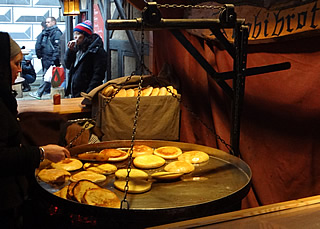


A beautiful city on the banks of the Elbe, with great Christmas Markets - one of our favourites.



We arrived quite late in the evening and took a taxi from the airport to our hotel, the Steigenberger on Neumarkt. A lovely hotel and very central for all the Christmas Markets - not least the one right outside on Neumarkt which we went straight to after dropping off our luggage in the room. First glühwein of the visit!
We passed through Neumarkt many times on our wanderings through the city. The Frauenkirche (Church of Our Lady)1 is one of the most recognisable buildings there, dominating the square. A church has stood here since the eleventh century and went through numerous incarnations before the Baroque building of George Bähr was erected in the eighteenth century, taking over twenty years from the planning stage before completion in 1743. The unique bell-shaped dome is a landmark of the city.
The church perished along with much of Dresden in the bombing and subsequent firestorm of WW2 but was reconstructed between 1994 and 2005, using as much of the original material as possible.



The following morning was bright and sunny as we made our way to the Zwinger Palace. It has an entrance from Theaterplatz where Semperoper is also situated.
A very grand Baroque building, commissioned by Augustus the Strong, Elector of Saxony and King of Poland in the early 18th century, the Zwinger was modelled on Versailles and is set in manicured grounds.
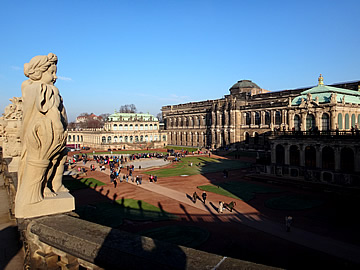


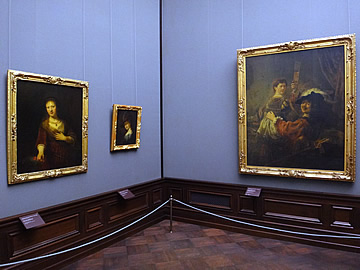


The Altes Meister Gallery was our destination in the Zwinger. Among many fine artworks it holds a wonderful Hans Holbein, superb Rembrandts, several by Canaletto and his pupil Bernardo Bellotto, and a number by Lucas Cranach.
There are quite a few paintings of Dresden in centuries past which highlight how the city has changed - many buildings are still standing, if reconstructed after Second World War bombing.




Dresden Striezelmarkt in the Altmarkt is massive and the oldest Christmas market in Germany, with hundreds of stalls, plenty to eat and drink, and a ferris wheel.


We had a superb roasted ox sandwich here!


The stalls were all beautifully decorated, especially the roof lines, where a lot of trouble had been taken with greenery and Santa Clauses and other models and baubles.




 .
.Of course, everything is more magical at night when the lights glow against a dark sky.
 .
.




From the sixteenth century the Residenzschloss was the seat of the rulers of Saxony, though the current architecture is mostly of the sixteenth century. It is now home to a number of museums.
The rich treasure chest known as the Historiches Grünes Gewölbe (Historic Green Vault) is one of the collections housed in the Residenz. The Treasury of Augustus the Strong holds fabulous amber pieces, including a magnificent cabinet, an awful lot of ivory, and a stunning collection of jewels. No photography is allowed.
Other parts of the museum hold many fascinating and precious artefacts and we were particularly impressed by the huge and beautiful Ottoman tents in the Turkish Chamber.

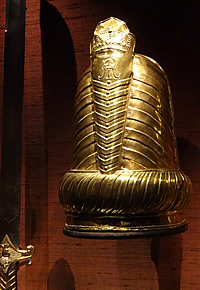


Augustus the Strong (1670-1733) who ruled as Elector of Saxony (he was also elected King of Poland) was responsible for much of the Baroque splendour of Dresden, including the Zwinger. In 1730 he planned a great tented city for an Ottoman-style military camp which became known as the Zeithainer Lustlager.
I particularly enjoyed seeing an enormous Janissary cauldron, being a big fan of the books of Jason Goodwin. In his "The Janissary Tree" the history and practices of this elite corps of Turkish troops are interwoven with the story. The Janissary traditions are linked to food, particularly soup, and the sultan providing for his subjects. The high-ranking Janissary officers were known as "soupiers" and woe betide any sultan whose Janissaries overturned their cauldrons, symbolic of rejecting the sultan's food and a sign of serious discontent.

The Neues Grünes Gewölbe (New Green Vault) holds around a thousand pieces, including many fascinating and intricate works of art such as a rolling ball clock, a golden statuette of Daphne at the moment of her metamorphosis into a bay tree, a cherry stone carved with 185 faces, a bizarre automaton drinking vessel, and a magnificent jewel-studded representation of the birthday celebrations of the Mughal Emperor of India, Aurangzeb.



















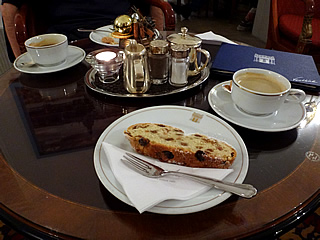




The Medieval Christmas Market is held in the Stallhof very close to the Frauenkirche in an original sixteenth century jousting space.
There was an entrance charge but it was worth it. It was really atmospheric with most stalls in keeping with the medieval theme.

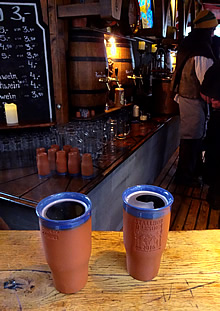
The best glühwein was here - and the best beakers - now my favourites for glühwein at home! There were lots of different themed stalls plus a blacksmith and a fire eater, and the music was really excellent.
